For a large part of this season, Sheffield Wednesday have been the team to beat in EFL League One, with Darren Moore’s side having a heavily impressive defensive record. However, over the weekend, they suffered a shock defeat at the hands of Forest Green Rovers, who currently sit bottom of the league table, which sees them lingering two points off the top spot, currently occupied by Plymouth Argyle (although the Owls do have a game in hand on Argyle).
Wednesday are still in the automatic promotion places, so earning a place in the Championship next season is still very much a realistic option.
This means that the Owls are now without a win in three, a worrying patch of form for Wednesday fans at the business end of the season. The win, while a big scalp for Duncan Ferguson’s side, does very little in regards to their fight for survival – this was just their sixth win of the season and they are still 11 points from safety, with a significantly worse goal difference than the teams around them.
This tactical analysis will look at the tactics deployed by Forest Green as they successfully kept Sheffield Wednesday at bay, while there will also be an analysis of Wednesday’s approach as we try to find out why it failed.
Lineups
Hosts Forest Green use a 4-4-2 these days, which harks back to Big Dunc’s time as an Everton player. Ross Doohan came into the side to make his 10th league appearance of the season between the sticks. Udoka Godwin-Malife came back into the fold, partnering with Brandon Cooper in the heart of the defence. Ferguson made one change to his midfield lineup from their previous fixture, a 2-0 defeat away at league leaders Plymouth. That change came in the form of Jordon D’Andre Garrick, who replaced Corey O’Keefe on the left flank. There were no changes to the front line: Charlie Savage starting again with his father, Robbie, formerly of Manchester United and Leicester City watching on from the stands.
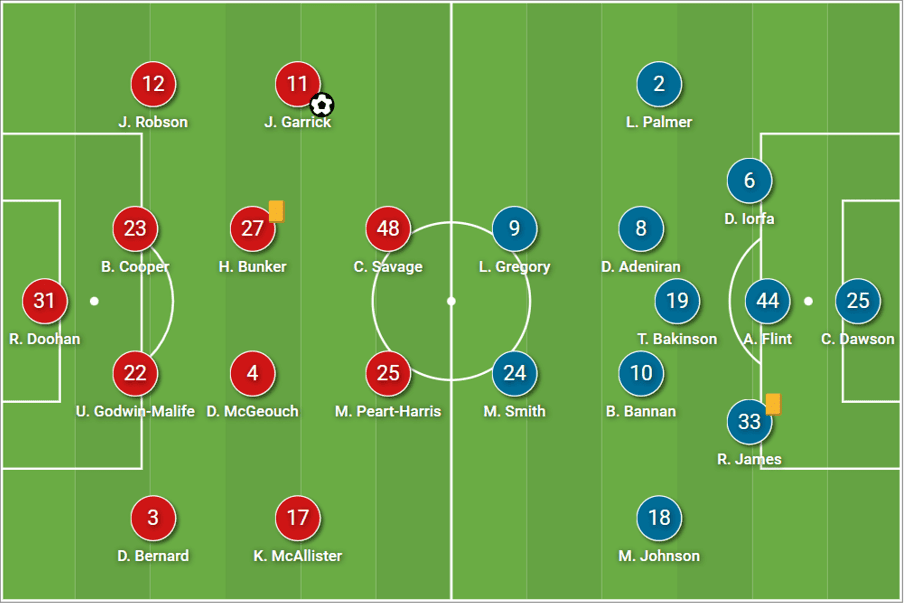
Visitors Sheffield Wednesday lined up in a 3-5-2 shape, making one change in defence – Reece James coming in at LCB for Akin Famewo. There was also one change in the midfield trio, with Will Vaulks starting ahead of Tyreeq Bakinson, with Barry Bannan also present. Michael Smith and Lee Gregory both kept their places from the Owls’ previous game, a 4-2 defeat to South Yorkshire counterparts Barnsley.
Wednesday wasteful in possession
Darren Moore’s side have scored 64 times in League One so far this season, with only Ipswich Town and Plymouth scoring more than the Owls – making it even more surprising that Wednesday came away from this fixture goalless. In fact, they only registered six shots in the tie (the same as Forest Green), with just one of those being on target. So it’s not even like they tested the keeper a great deal despite controlling a large portion of possession.
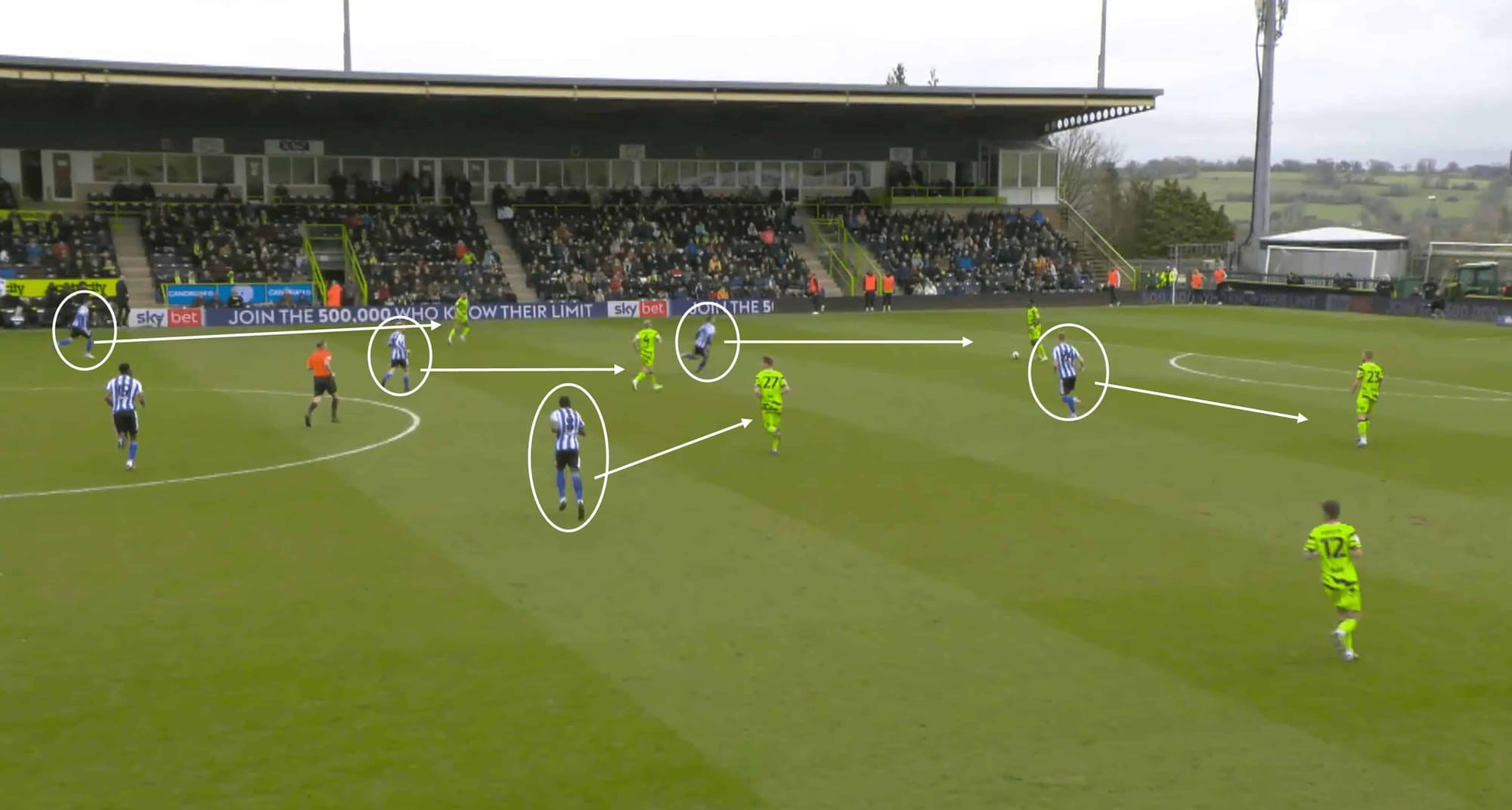
According to our data, Wednesday registered 69% possession in this tie, which in many ways was to be expected, but it was their pressing out of possession that played a big part in this. As we will discuss in a later section of this analysis, Forest Green did show some quality in possession that wasn’t just direct play, but a lot of the time, Wednesday’s high press forced a quick long ball from the hosts, which in turn often resulted in a turnover in possession.
Wednesday’s front two would press FGR’s central defenders, while the midfield unit would be on standby to press their positional counterparts if the ball arrived in their respective area.

Before we look at some examples of Sheffield Wednesday’s attacking tactics, this heatmap gives us some context in regard to their struggle in hurting their opponent in the final third. As you can see, the Owls were most present in the midfield regions, especially the wide areas – this could tie into their struggle in linking midfield to attack. The visitors usually average an xG of 1.48 per game this season, but managed just 0.83 this time around; huge signs that they struggled to create even half chances.
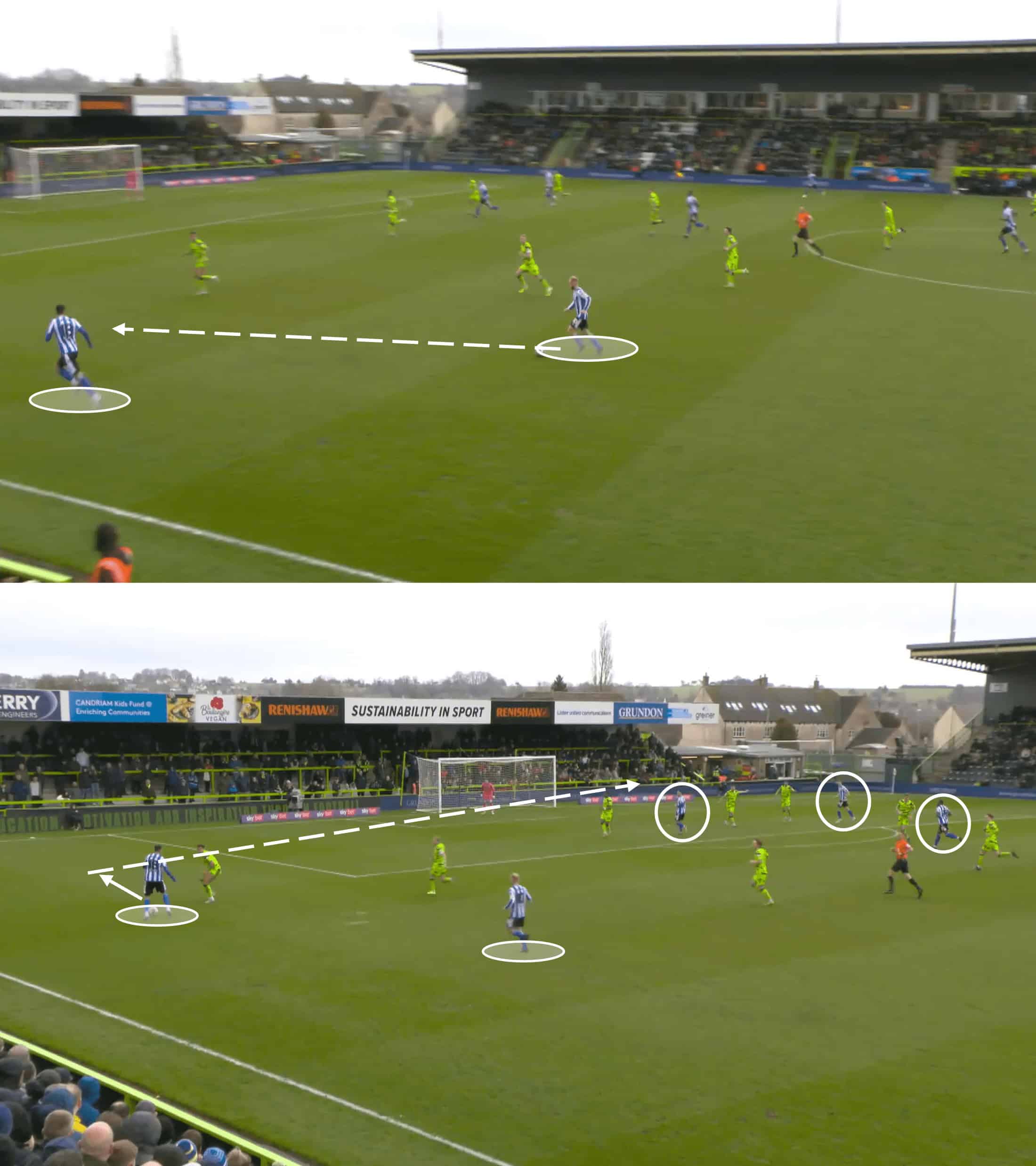
With two strikers on the pitch, against a team whose match tactics focus on the defensive side of things, getting the ball into wide areas before delivering a cross was Wednesday’s preferred method of attack. Former Celtic youngster Barry Bannan would often pull the strings from the middle to get the ball into these wide areas, but he didn’t have his best day either, giving the ball away on multiple occasions.
The example above shows Bannan linking the play into a more dangerous wide area, giving LWB Marvin Johnson a chance to attack. Upon being fronted up by a Forest Green defender, Johnson shifts the ball into a position that allows him to swing a cross into the box. However, this is where the problem was for the Owls – far too often, the quality of the final ball was frustratingly poor. Wednesday attempted a whopping 30 crosses in this game, with 10 of them being accurate – these numbers do include ground passes into the box from wide areas. On face value, those are good numbers, but what the numbers don’t show is that Wednesday wasted numerous chances that just required a simple pass/cross to create a dangerous chance on goal, but failed.
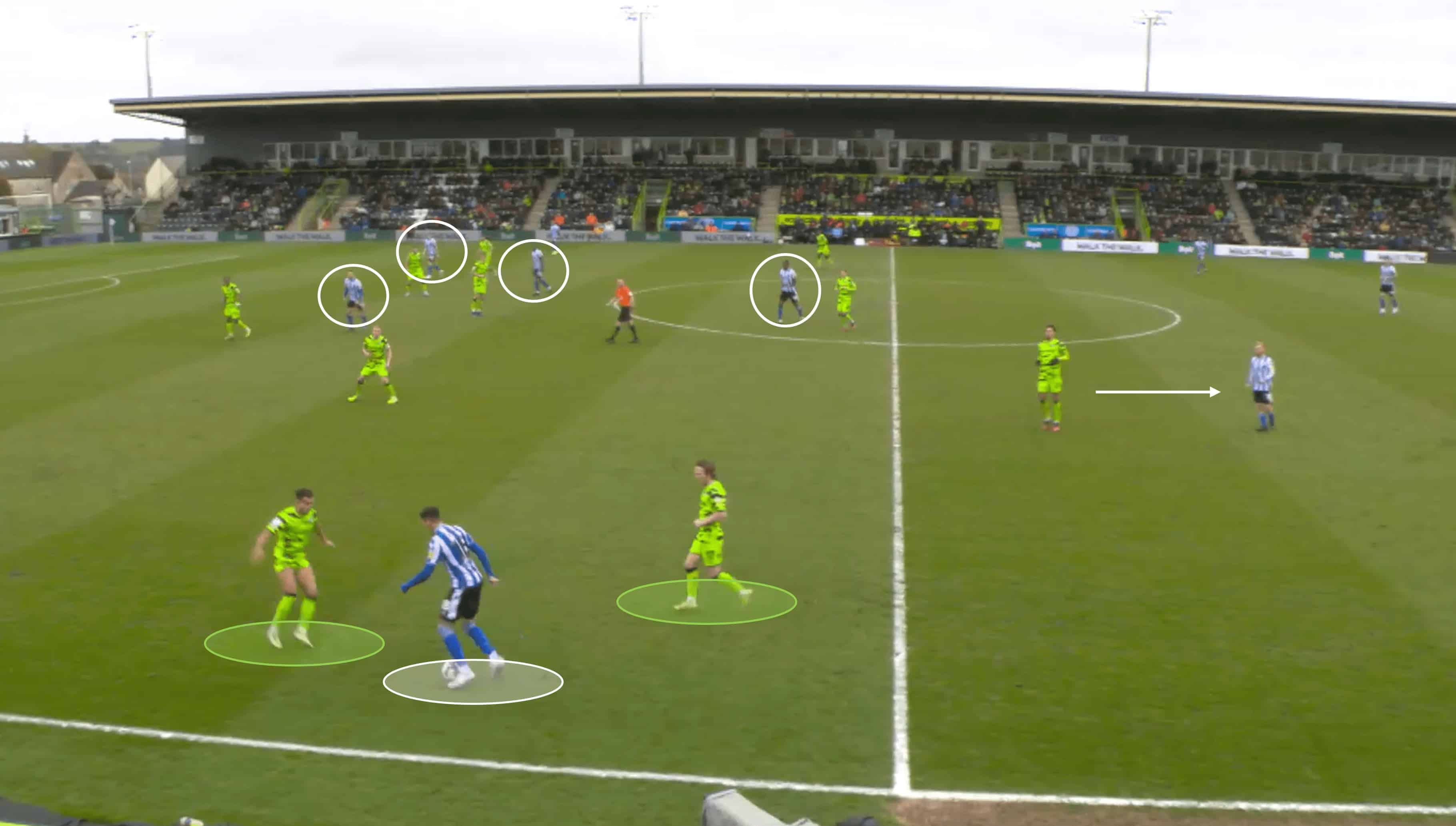
While Darren Moore didn’t get a great deal wrong, tactically speaking, failure to execute a plan B/over-reliance on plan A didn’t help their cause. On a number of occasions, Wednesday looked disjointed in possession, struggling to put together passing combinations or progress the play up the pitch. The example above links into that reliance on one method in a way, as there were signs that something needed changing.
Johnson sometimes found himself isolated in possession with no support close by, but the attacking unit is positioned centrally anticipating a pass of some kind. The positioning of those attacking players seemed premature and should have been executed later on in the attack, especially after seeing their teammate in a 2v1 scenario in a wide area with nobody to pass to.
This could also link to the formation (3-5-2). Not that the 3-5-2 is the wrong formation for Moore’s side – it has obviously done the trick so far. However, one thing that this system doesn’t offer is the full-back & winger partnership – changing formation to try and impact the game could have been the answer for more effective play in wide areas. Instead, the wing-back is more or less left to do all of the wide work themselves. Now, usually, you would expect the midfield unit to play in line with this notion, but the image above shows that Wednesday didn’t get this right on the day.
Forest Green’s fearless first half
Ferguson’s side sit 11 points adrift of safety with eight games left, so it would take some miracle for them to avoid the drop. Maybe this fed their courageous display in this tie, as their first-half performance did not resemble that of a side staring relegation in the face. While Rovers still had less possession than their opposition, the game was significantly closer in the first 45, with Forest Green showcasing some effective passing combinations and generally positive play in possession.
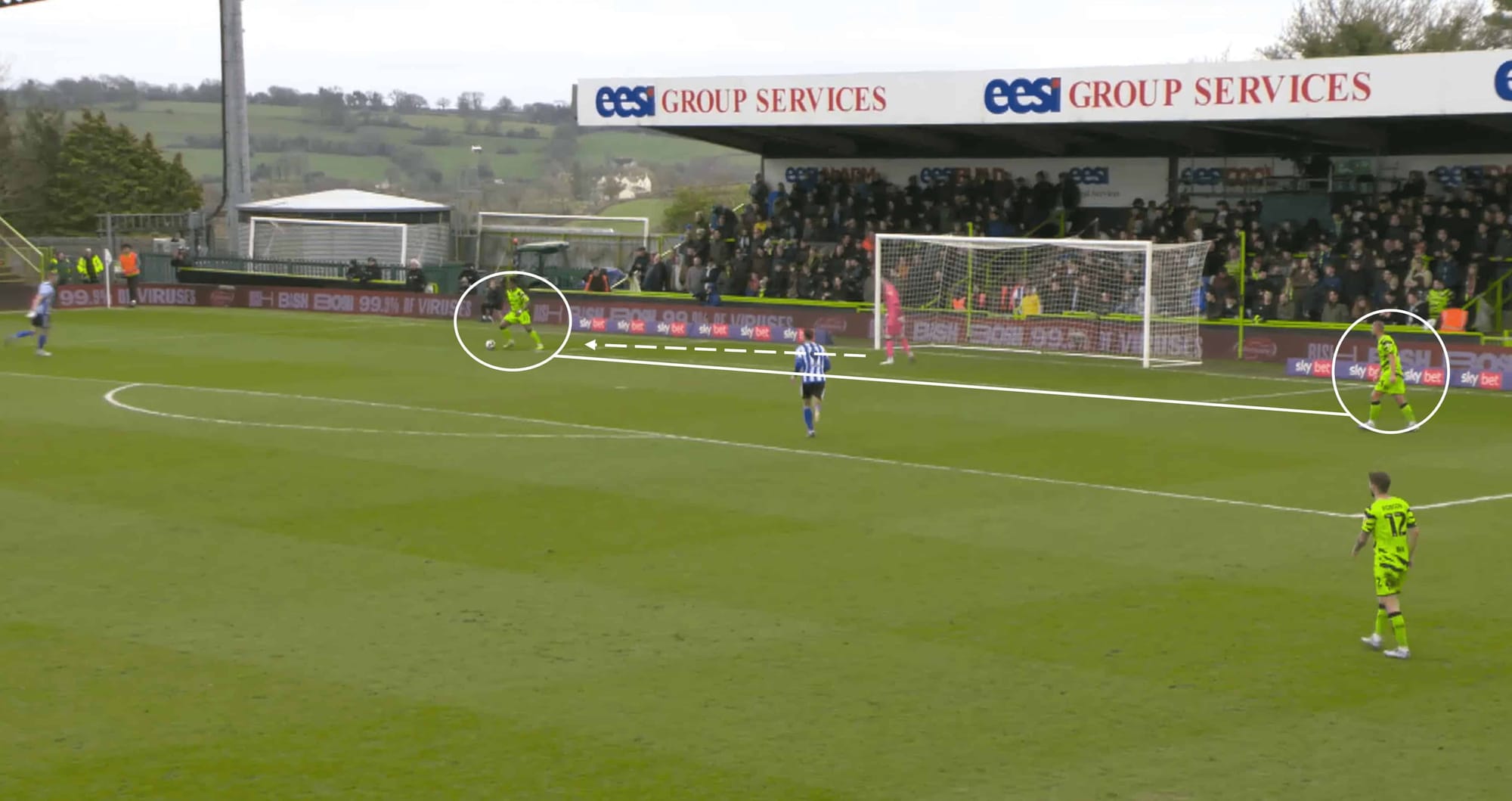
Something that you won’t often see from a club that sits bottom of their league is the desire to play out from the back from goal kicks, but that is exactly what Forest Green offered. Now, obviously, this wasn’t possible every single time, and they sometimes had to return to their direct routes, but this same courage in possession was also reflected in their impressive combination play further up the pitch.

Ironically, the example above shows a passing combination – just the kind that Wednesday were sometimes missing in their wide play! Forest Green were confident in beating the initial Owls press, and were often successful in doing so, but rarely did they bite off more than they could chew. Take the example above: the pass goes down the line before being bounced back inside to the central midfielder. Although he has space in front of him, he takes very little time before he launches a ball over the top for his striker to chase down.
Just in that decision alone, there is a lot to unpack. Was it a conscious decision to avoid leaving his position unguarded by driving forward with the ball? Or did his instincts in line with the tactics kick in? It’s difficult to say, but if Rovers were able to play their way out of defence into midfield like that every week, their season might have unfolded slightly differently.
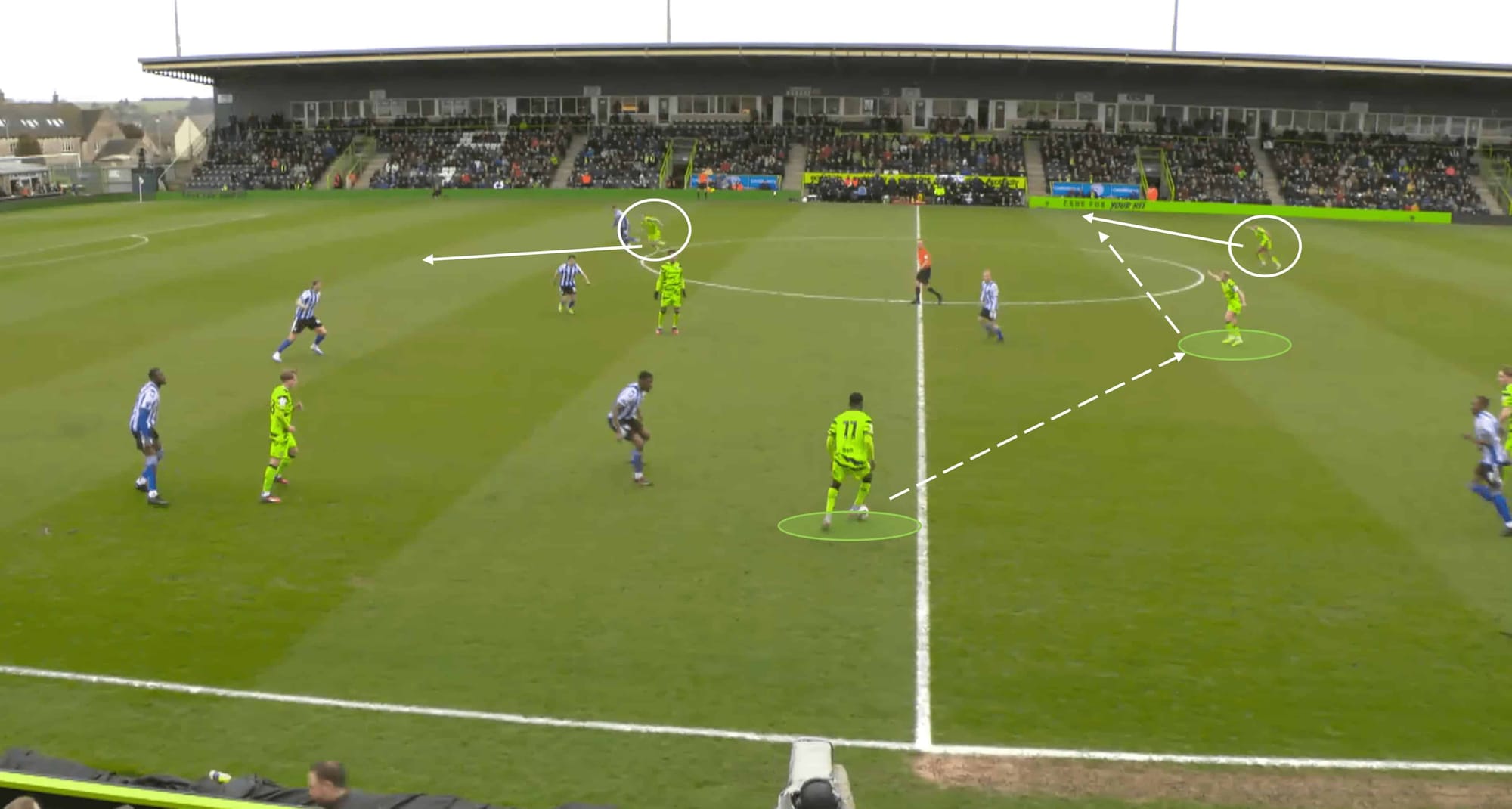
Often, a sign of a confident team is the hunger, energy, and aggression they show in possession. Above, goalscorer Garrick is facing inwards after cutting inside, giving himself some nice room to work with.
One option that, had Garrick spotted the run, could have been dangerous was the run of right midfielder Kyle McAllister, who looked to get beyond the blue and white shirt. Garrick didn’t seem to spot the run but was able to pick out a pass that allowed his side to build possession nicely. His pass went inside to his midfield teammate, who in turn shifted the ball onto the run of right-back Dom Bernard. This passage showed brains and confidence, and it was moments like this when you would’ve been forgiven for assuming Forest Green weren’t bottom of the league.
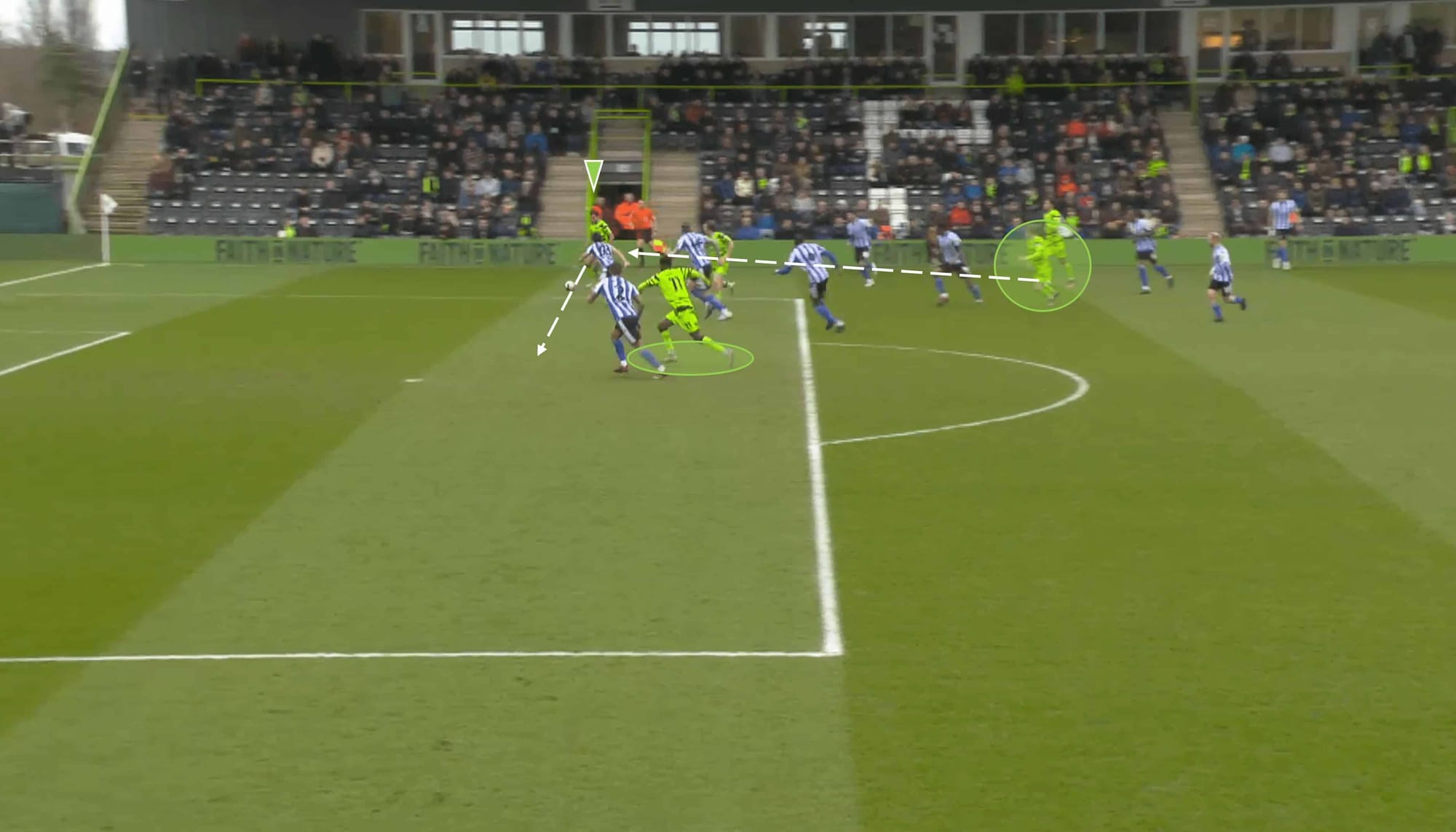
They showed a similar combination of confidence and quality to find the only goal of the game. After working the ball into the final third from a throw-in, the ball found itself at the feet of Savage, who carved out a clever pass into the path of the oncoming Bernard. The full-back showed great poise to ping a well-executed cross into the path of Garrick, who was able to beat his marker to the ball, putting his side 1-0 up. Clever play from all three mentioned there – Savage’s awareness and reactions to get into position initially before timing his pass well; the attacking awareness and desire from Bernard to get involved in a key moment; and the pace and off-the-ball movement from Garrick to get into the right area in the box.
While Forest Green did offer some attacking action after their goal, their defensive focus increased, particularly in the second half, with Sheffield Wednesday piling on the pressure as they searched for an equaliser.
Forest Green’s defensive resolve
A number of factors played into Forest Green claiming a clean sheet against a title contender. We’ve mentioned Sheffield Wednesday’s poor attacking display, but the energy and commitment demonstrated by Forest Green just made life very difficult for the Owls. Forest Green were forced to defend for a large part of the game, namely the second half, but Wednesday had very little joy in the final third – in this final analysis segment, we will look at Forest Green’s shape off the ball.
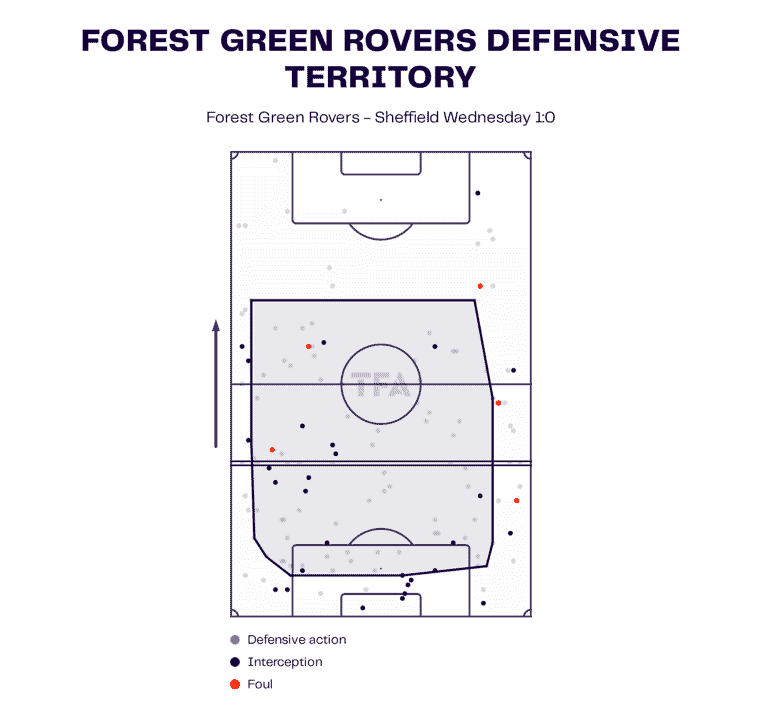
The map above shows us where Forest Green were positioned as a defensive unit, over the course of the match, based on their defensive actions. Unsurprisingly, they were very active in their own defensive third thanks to Sheffield Wednesday’s second-half onslaught, but they were also very busy in midfield areas. One piece of credit that Forest Green deserve is how they gave away just one foul in the final third – often when teams are defending with their backs to the wall against a possession-dominant side, they give away a high number of fouls. Rovers conceded just five in this tie.
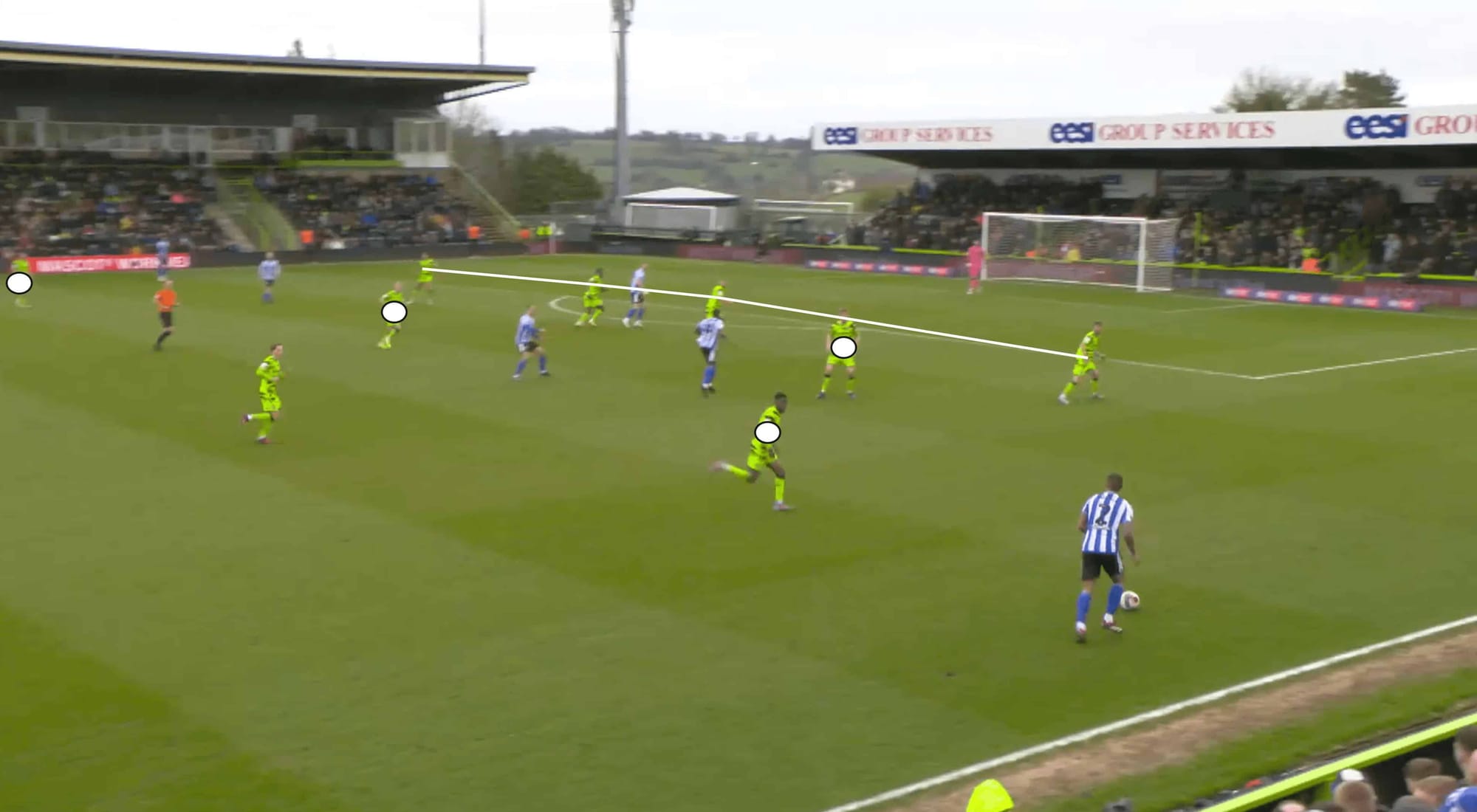
And this would typically be the shape that we’d see from a defending Forest Green – just deeper and more compact as the game went on and as Wednesday’s attacks became more frequent and intense. The back four operated as you’d expect, and the midfield offered good defensive protection to their back line – the wide midfielder on the flank opposite to the possession would stay wide to mark the Owls wing-back on his side, rather than tucking inside. We would also often see the front two come back to offer their assistance in defence and were tasked with pressing the Wednesday defenders when they had comfortable possession.
Conclusion
This was a mixture of a courageous and fearless performance from Forest Green Rovers, who took their chance very well before proceeding to defend effectively, and a poor performance from a Sheffield Wednesday team that has been on fire with the goals this season.
Wednesday never really got settled in the game, and their play resembled that of a team chasing a goal in the last minute of the game, but for 90 minutes – desperate, with little structure to their play. They will need to dust themselves off before their next fixture against Cheltenham Town, as Ipswich are breathing right down their necks for a place in the automatic promotion spots.

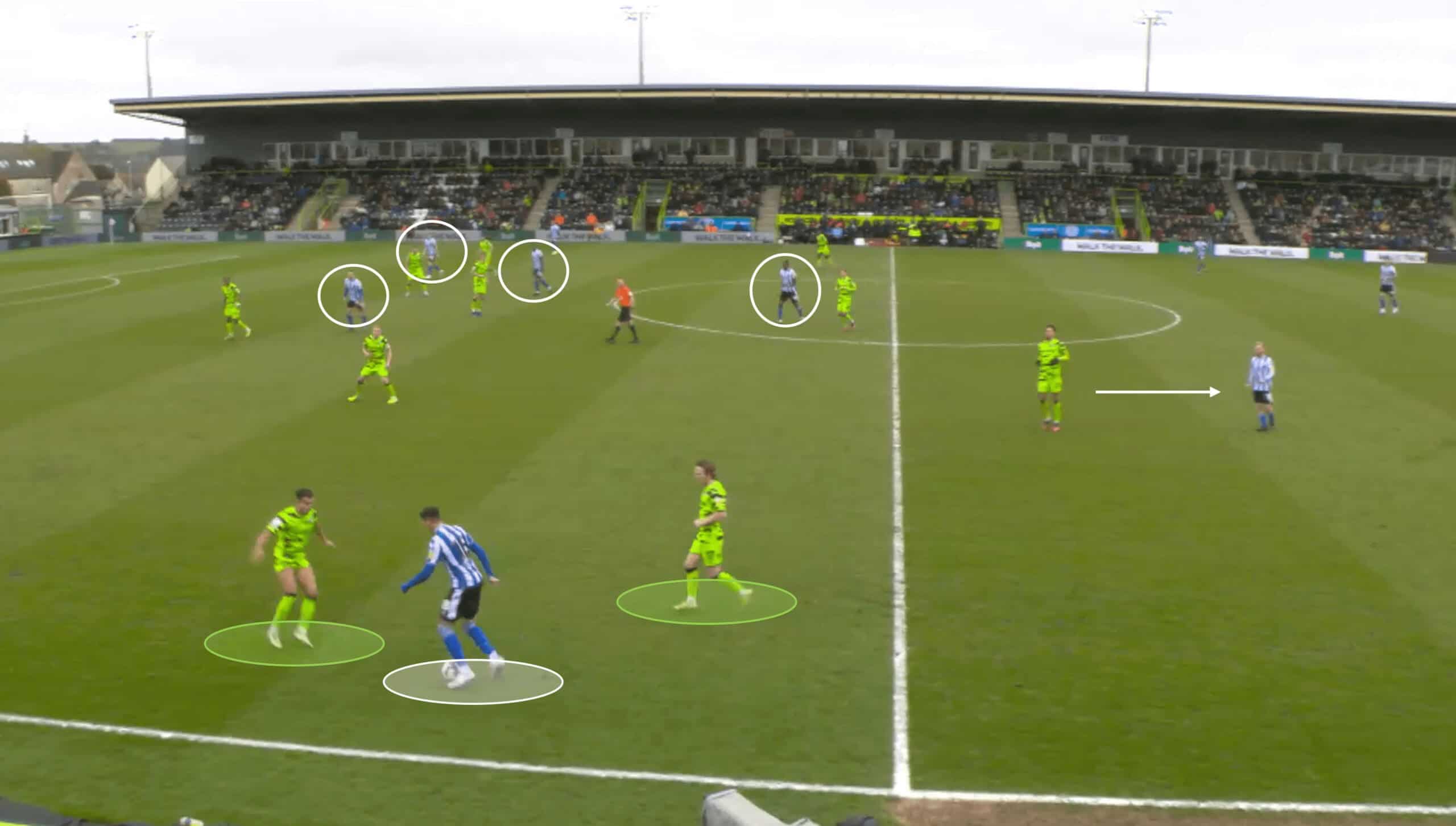




Comments